markz528
Hot Rolled
- Joined
- Sep 25, 2012
- Location
- Cincinnati

I need to make the alternator bracket for my 65 Fury cop car as I have been unsuccessful in finding one (see picture of my first prototype pattern). It will be sand casted out of ductile iron. I have never had anything cast before.
Made the first prototype from oak. That did not go too well. Oak seems to be quite porous after machining, and it actually pulled some material in spots.
Made some adjustments to the shape and made the next prototype out of poplar. Again the finish is not great but no pulling and I would like to use a better material that will finish better.
Someone suggested Maple. I can get Maple but not that easily. Is Maple the right choice or is there a better material to use for a sand casting pattern that will be used to make 2 castings?

